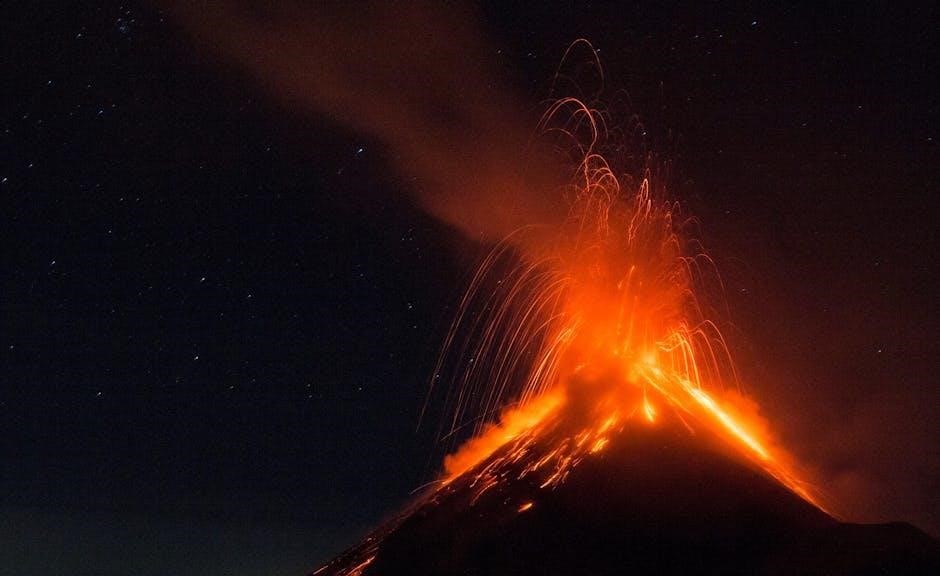Plate tectonics is a fundamental theory explaining Earth’s dynamic surface. It describes how lithospheric plates move, shaping landscapes and causing geological phenomena like earthquakes and volcanoes.
1.1 What is Plate Tectonics?
Plate tectonics is the scientific theory that describes the Earth’s lithosphere as being divided into large, rigid plates that move relative to each other. These plates float on the asthenosphere, driven by convection currents in the mantle, shaping Earth’s surface through processes like earthquakes, volcanoes, and mountain formation.
1.2 Importance of Studying Plate Tectonics
Studying plate tectonics is crucial for understanding Earth’s dynamic processes, such as earthquakes, volcanoes, and mountain formation. It helps explain natural disasters, resource distribution, and the ever-changing landscape. This knowledge aids in predicting seismic activity, preparing for hazards, and understanding Earth’s history, making it essential for geologists, researchers, and the general public to grasp our planet’s behavior and evolution.
Structure of the Earth
The Earth is composed of distinct layers: crust, mantle, outer core, and inner core. The lithosphere, including the crust, floats on the fluid asthenosphere below, enabling plate movement.
2;1 Layers of the Earth
The Earth is divided into four primary layers: the crust, mantle, outer core, and inner core. The crust is the outermost layer, ranging in thickness from 5-70 km. Beneath it lies the mantle, a dense, viscous layer over 2,800 km thick. The outer core is a liquid iron-nickel alloy, while the inner core is a solid, iron-rich center. These layers vary in composition and temperature, playing crucial roles in plate tectonics and Earth’s geophysical processes.
2.2 Lithosphere and Asthenosphere
The lithosphere is the Earth’s outermost layer, comprising the crust and upper mantle, rigid and broken into tectonic plates. Beneath it lies the asthenosphere, a viscous, partially molten layer allowing the lithosphere to move. The asthenosphere’s fluidity enables plate tectonics, with convection currents driving plate motion and shaping Earth’s surface through geological activity like earthquakes and volcanoes.
Types of Tectonic Plates
Tectonic plates are primarily oceanic and continental. Oceanic plates are denser, composed of basalt, while continental plates are less dense, made of granite. They interact dynamically.
3.1 Oceanic and Continental Plates
Oceanic plates are denser, primarily composed of basalt, and tend to subduct under continental plates, which are less dense and made of granite. This difference in density drives plate interactions, influencing geological events like subduction zones and mountain formation. Understanding these plate types is key to explaining phenomena such as deep-sea trenches and volcanic arcs.
3.2 Differences Between Plate Types
The primary distinction between oceanic and continental plates lies in their composition and density. Oceanic plates are thinner, heavier, and basaltic, while continental plates are thicker, lighter, and granitic. These differences dictate their behavior at boundaries, such as subduction, where denser oceanic plates sink beneath lighter continental plates, driving processes like earthquakes and volcanic activity.
Plate Boundaries
Plate boundaries are zones where tectonic plates interact, resulting in earthquakes, volcanoes, and mountain formation. They include divergent, convergent, and transform boundaries, each with distinct geological features.
4.1 Divergent, Convergent, and Transform Boundaries
Divergent boundaries occur where plates move apart, producing new crust. Convergent boundaries involve plates colliding, often forming mountains or subduction zones. Transform boundaries feature plates sliding past each other horizontally, like the San Andreas Fault. These interactions drive geological activity, shaping Earth’s surface through processes like volcanism, earthquakes, and mountain building;
4.2 Examples of Each Boundary Type
Divergent boundaries, like the Mid-Atlantic Ridge, show plates moving apart, creating new oceanic crust. Convergent boundaries, such as the Andes Mountains, involve subduction of the Nazca Plate under the South American Plate. Transform boundaries, exemplified by the San Andreas Fault, feature plates sliding horizontally past each other without creating or destroying crust.
Plate Movement and Processes
Plate movement is driven by convection currents in the mantle, creating processes such as subduction and mid-ocean ridges, shaping Earth’s surface over millions of years.
5.1 Convection Currents in the Mantle
Convection currents in the mantle drive plate tectonics. Hot mantle material rises, cools, and sinks, creating a circulation that propels lithospheric plates. These movements, though slow, shape Earth’s surface, forming mountains, volcanoes, and oceanic ridges. The process is continuous, with heat from Earth’s core fueling the convection, making it a key mechanism behind geological activity and plate boundary interactions.
5.2 Processes at Plate Boundaries
At plate boundaries, tectonic plates interact, causing geological phenomena. Divergent boundaries create new crust as magma rises, while convergent boundaries result in subduction or collision, forming mountains and volcanoes. Transform boundaries involve plate sliding, generating earthquakes. These processes shape Earth’s surface, driving volcanic activity, seismic events, and the formation of mountain ranges and oceanic trenches.

Geological Features Formed by Plate Tectonics
Plate tectonics creates diverse geological features, including mountains, volcanoes, and oceanic ridges. These formations result from crustal movements, magma activity, and earthquakes at plate boundaries.
6.1 Mid-Ocean Ridges and Volcanoes
Mid-ocean ridges are vast underwater mountain ranges formed by plate divergence. As tectonic plates separate, magma rises, solidifies, and creates new oceanic crust. This process is accompanied by volcanic activity, producing seamounts and hydrothermal vents. These features are key indicators of seafloor spreading and the dynamic nature of Earth’s lithosphere, shaping our understanding of plate tectonics and geological processes.
6.2 Mountain Building and Faults
Mountain building occurs at convergent plate boundaries where plates collide, causing the Earth’s crust to thicken and fold. Faults are fractures where rocks move past each other due to tectonic stress; These features provide evidence of plate interactions, with fault types including normal, reverse, and transform faults, each linked to specific plate movements and stress release mechanisms.

Evidence Supporting Plate Tectonics
Theory is supported by fossil evidence, mid-ocean ridges, and seismic activity. Fossils of ancient species match across continents, while oceanic ridges show seafloor spreading and magnetic stripes align with plate movements.
7.1 Continental Drift and Fossil Evidence
Continental drift, proposed by Alfred Wegener, is a key foundation of plate tectonics. Fossil evidence, such as Mesosaurus and Glossopteris, found on multiple continents, supports the idea of landmasses once being connected. Matching fossils across continents suggest they were part of a single supercontinent, Pangaea, which began to break apart millions of years ago.
7.2 Seismic Activity and Plate Boundaries
Seismic activity is closely linked to plate boundaries, where tectonic plates interact. Earthquakes primarily occur along these boundaries due to plate movement. Divergent boundaries feature volcanic activity, while convergent boundaries often result in subduction zones, producing deep earthquakes. Transform boundaries, like the San Andreas Fault, experience horizontal movement, causing shallow quakes. This alignment of seismicity with plate edges strongly supports tectonic theory.
Importance of Plate Tectonics
Understanding plate tectonics is crucial for explaining natural disasters, geological formations, and Earth’s surface changes. It helps predict earthquakes, volcanic eruptions, and tsunamis, aiding in disaster preparedness and resource management.
8.1 Understanding Natural Disasters
Plate tectonics provides insights into natural disasters like earthquakes and volcanic eruptions. By studying plate movements and boundaries, scientists predict seismic activities and volcanic events, enabling early warnings and evacuation plans. This knowledge helps mitigate risks, saving lives and reducing property damage in disaster-prone areas.
8.2 Impact on Earth’s Surface
Plate tectonics shapes Earth’s surface through processes like mountain building, oceanic ridge formation, and faulting. These activities create diverse landforms, influencing ecosystems and human settlements. Understanding these impacts helps us appreciate Earth’s dynamic nature and manage natural resources effectively, ensuring sustainable development and environmental conservation for future generations.

Study Resources and Answer Key
Various study resources, including PDFs and online quizzes, provide comprehensive materials for exam preparation. Answer keys offer detailed explanations, enhancing understanding of plate tectonics concepts and key theories.
9.1 Types of Study Materials Available
Available study materials include multiple-choice questions, short answer formats, and downloadable PDFs. Resources like CliffsNotes and OCR study guides provide detailed explanations. Online platforms offer interactive quizzes and practice exams. Answer keys are also available, covering topics like plate boundaries and geological features, helping students assess their understanding and prepare effectively for exams on plate tectonics.
9.2 How to Use the Answer Key Effectively
To use the answer key effectively, review questions and compare your answers. Focus on understanding mistakes by revisiting relevant concepts. Use the key to identify weak areas and track progress over time. Regular practice with the provided materials enhances retention and improves exam performance, ensuring a thorough grasp of plate tectonics.

Practice Questions and Answers
Engage with multiple-choice and short-answer questions to test your understanding of plate tectonics. Topics include plate boundaries, convection currents, and geological features, ensuring comprehensive preparation.
10.1 Multiple-Choice Questions
Test your knowledge with multiple-choice questions covering key concepts in plate tectonics. Topics include plate boundaries, seismic activity, and geological features. Questions are designed to assess understanding of processes like convection currents, subduction, and continental drift. Difficulty levels range from basic to advanced, ensuring comprehensive preparation. Answer keys are provided for self-assessment and improved learning outcomes.
- Covers plate boundaries and interactions.
- Includes seismic activity and geological formations.
- Answer key provided for verification.
10.2 Short Answer and Essay Questions
Engage with in-depth questions requiring detailed explanations. These assess critical thinking and comprehension of complex topics like plate interactions, geological processes, and evidence supporting tectonic theories. Essay questions encourage analysis of case studies and real-world examples. Answer keys provide structured responses, aiding in thorough understanding and preparation for advanced assessments.
- Focuses on analytical and descriptive responses.
- Covers complex tectonic processes and theories.
- Includes case studies for practical application.
Plate tectonics is vital for understanding Earth’s dynamic processes. Study materials like answer keys and review sheets are essential for mastering concepts, ensuring exam readiness, and fostering deeper geological insight.
11.1 Summary of Key Concepts
Plate tectonics explains Earth’s surface dynamics through moving lithospheric plates. Oceanic and continental plates interact at boundaries, creating features like mid-ocean ridges and mountain ranges. Convection currents drive plate movement, supported by evidence such as seismic activity and fossil records. Understanding these processes is crucial for grasping geological phenomena and natural disasters.
11.2 Final Thoughts on Mastering Plate Tectonics
Mastering plate tectonics requires understanding its fundamental concepts, such as plate boundaries and processes. Utilize study materials like review sheets and practice questions to reinforce learning. Regularly testing knowledge through multiple-choice and short-answer exercises ensures comprehension. By applying these strategies, students can confidently grasp the dynamics of Earth’s lithosphere and its geological implications.
